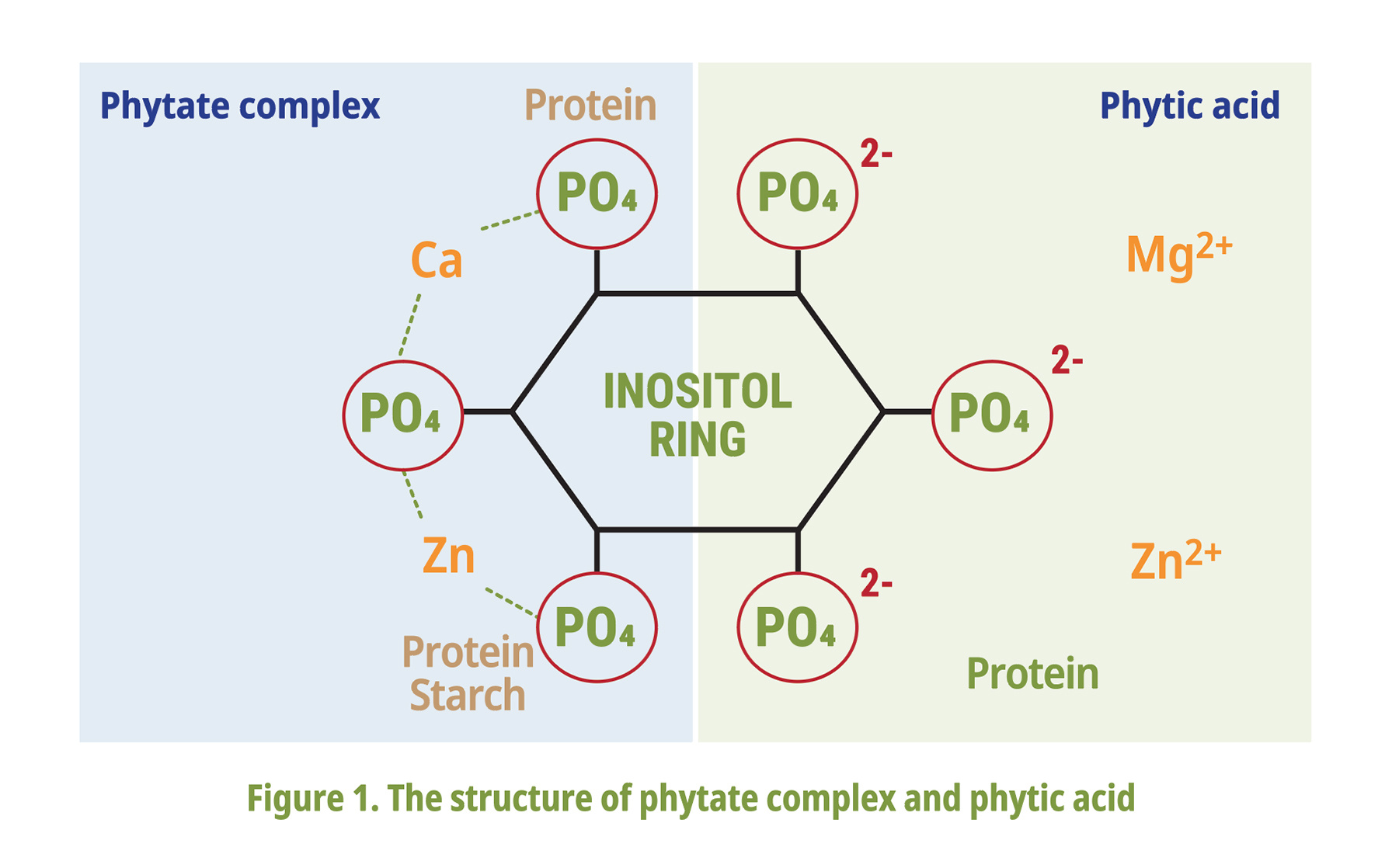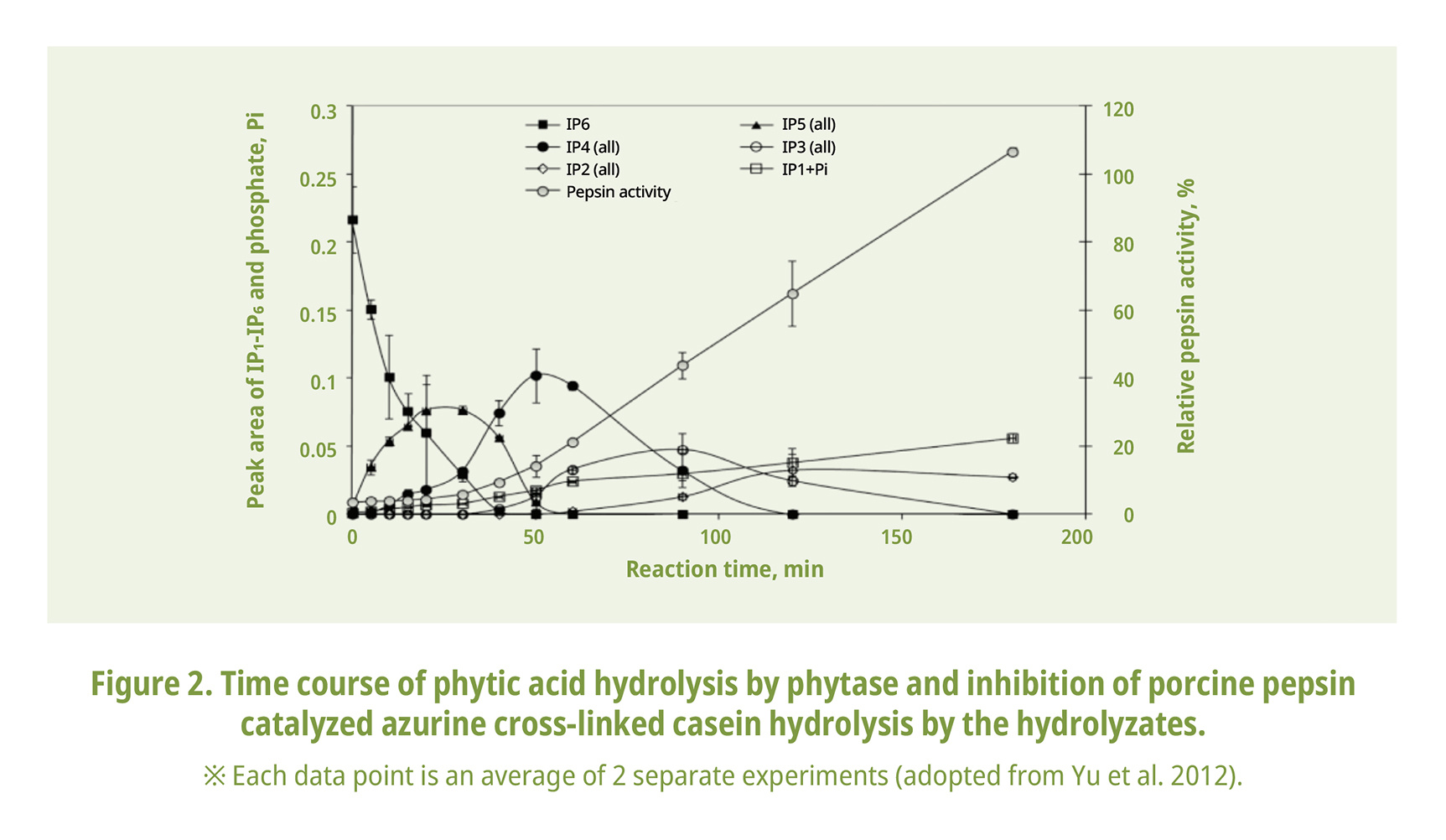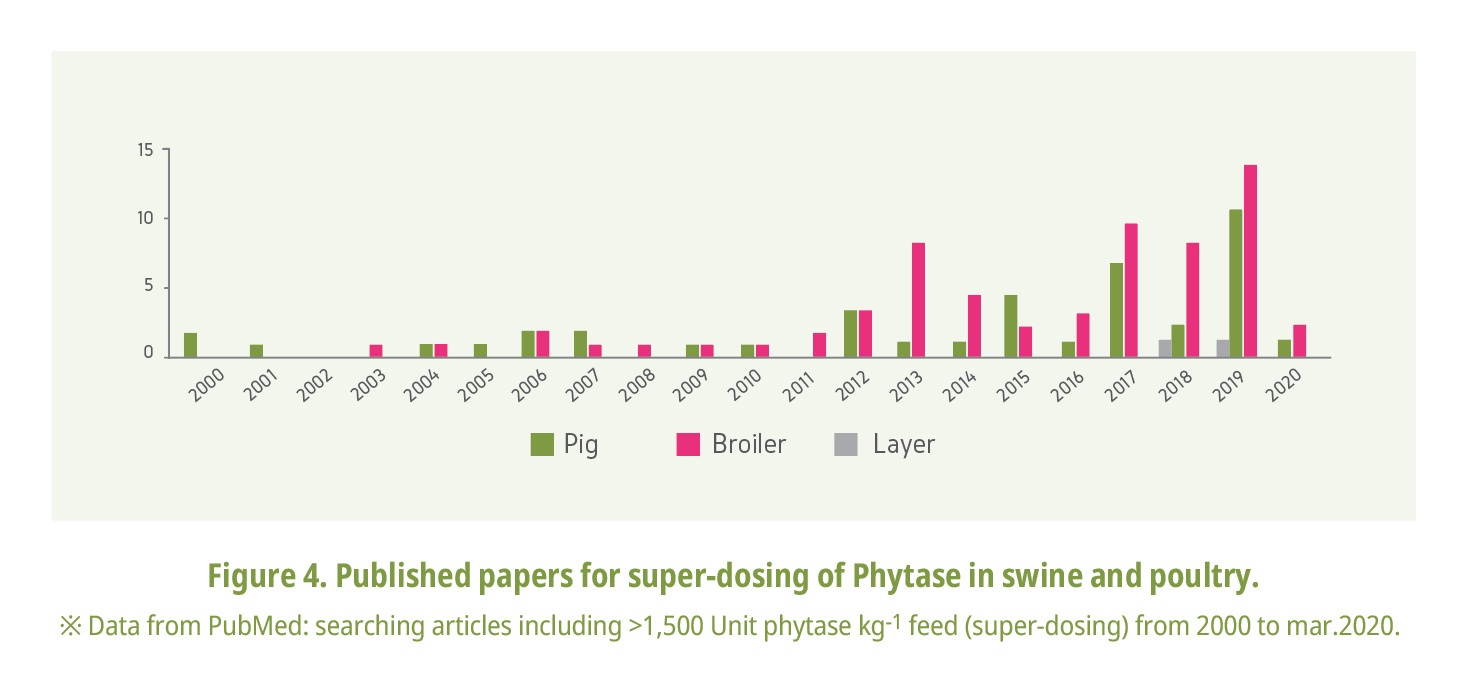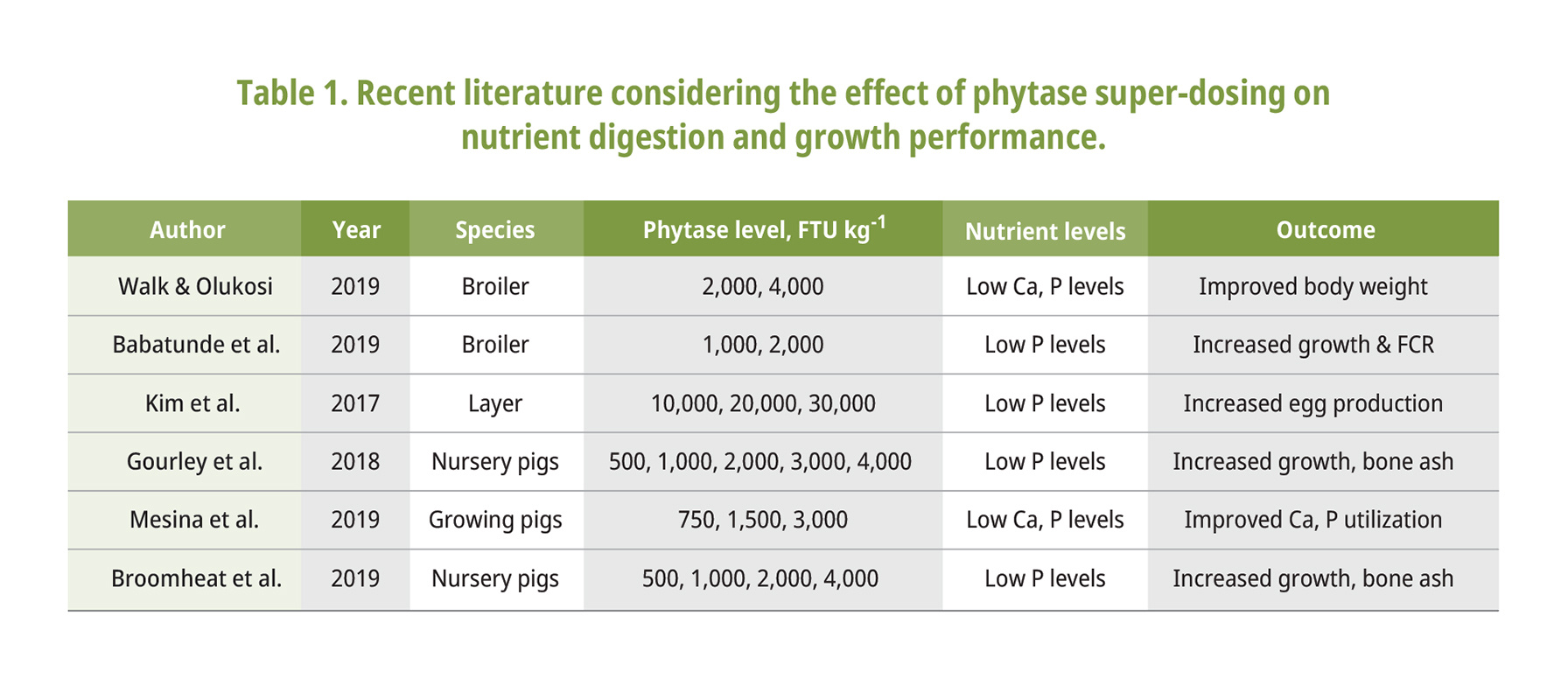Application of phytase in animal nutrition
2020년 06월 10일
- Function
- Nutrition
- Poultry
- Swine
WHAT IS PHYTASE?
Myo-inositol (1,2,3,4,5,6) hexakisphosphate phosphohydrolase, or phytase, catalyzes the hydrolysis of phytate into myo-inositol
and free phosphate. Among a variety of feed enzymes, phytase is known to be the most widely used in the feed industry. Phytase
is considered an essential enzyme by feed millers. Generally, one unit of phytase activity is defined as the amount of enzyme
required to release 1 μmol of inorganic phosphate per minute from sodium phytate at 37°C, pH 5.5, which is expressed as U (FTU).
In plants, phosphorus is stored as phytate, which contains 6 phosphate molecules bound around a myo-inositol ring and is degraded
through stepwise dephosphorylation by the phytase. About 65~90% of total phosphorus content in plants is in phytate form
(Reddy et al., 1982). Phytate digestibility is a challenge to pigs and poultry because of a very low activity of endogenous phytase
(Pointillart et al., 1987).
Phytate often chelates different mineral cations such as Ca, Mg, K, Mn, or Zn creating a mineral-phytate complex. Thus, phytate
reduces bioavailability of cationic minerals (Plimmer, 1913; Selle et al., 2009; Joshi-Saha and Reddy, 2015). Additionally, phytate may
interact with other nutrients, namely proteins, starch, and lipids, reducing their digestibility (Thompson and Yoon, 1984; Ravindran
et al., 2000; Newkirk and Classen, 2001).
Phytase hydrolyze phytate through stepwise dephosphorylation through which increases the absorption rate of various minerals,
especially the phosphorus. In addition, phytase improves the utilization of nutrients such as proteins (amino acids) and carbohydrates.
With increase of phosphorus digestibility via application of phytase, phosphorus excretion will be less. Thus, phytase helps
nutritionists to practice a sustainable and economical feed formulation.
Phytase has become a standard ingredient in pig and poultry diets due to the rising cost of inorganic phosphorus. Phytase breaks
down phytate making the phytate-bound phosphorus available. This allows to reduce the use of expensive inorganic phosphorus
(Selle and Ravindran, 2008).

PHYTASE SUPER-DOSING
Super-dosing means supplementing phytase in diets at rates above what is required to meet the animals requirement for
available phosphorus (Kies et al., 2006; Cowieson et al., 2011).
With a normal dose of phytase (500 FTU kg-1), myo-inositol phosphate ester 6 (IP6) will be broken into IP5. The normal phytase dose
will also break IP5 into IP4 and/or IP3. Thus, with normal phytase dosage accumulation of IP3 and IP4 will happen in the gut which
does not exist in diets free of phytase (Fig. 2). IP3&4 have a high solubility and can easily bind Zinc and other minerals. Super-dosing
(1500 FTU kg-1) will remove IP4 and IP3 (Yu et al. 2012) thus have the ability to improve minerals bioavailability. IP1-5 inhibits
pepsin activity. Thus, super-dosing improved protein digestion by means of increasing pepsin activity (Yu et al. 2012).

The earliest study to observe the impact of unconventionally high doses of phytase reported an additional release of phytate
phosphorus as a result of increasing phytase inclusion rate from 950 FTU kg-1 to 7,600 FTU kg-1 (Nelson et al., 1971).
General recommended dose of phytase in poultry is 500 FTU kg-1 diet (Selle and Ravindran, 2007; Cowieson et al., 2009; Pirgozliev
et al., 2012; Lalpanmawia et al., 2014), but today a range is proposed to adjust the dosage to the specific needs. Shirley and Edwards
(2003) observed a quadratic and linear increase in phytate phosphorus disappearance with increasing phytase dose in chicken diets
up to 12,000 FTU kg-1 in corn-based diets. On reflection there may be three principle mechanisms that the use of higher doses of
phytase has been gaining interest: 1) More liberated phosphate or restoration of P/Ca proportionate release, 2) Less residual
phytate ie destruction of the antinutritive effect and increased generation of more soluble lower esters, 3) Generation of myo-inositol
with vitamin-like/lipotropic effects (Cowieson et al., 2011). The use of super doses of phytase (>1,000 FTU kg-1 of diet) improves
nutrient availability in the feed (Cowieson et al., 2006). The high doses of phytase may result in a higher release of phosphate from
phytate and consequently an improved calcium to available phosphorus ratio with less residual phytate in the gut (Cowieson et al.,
2011). The standard dose of phytase can target intermediate-lower esters such as IP4 and/or IP3 but the concept of super-dosing
is able to liberate the phosphorus more efficiently from IP6 to IP1 at a lower pH which is upper gastrointestinal track (Fig. 3 ).

In the studies where the impact of high doses of phytase is observed, the phosphorus requirement was met with 500 to 750 FTU
kg-1 of phytase. Thus, performance improvements with phytase above 750 FTU kg-1 is related to mechanisms separate from
meeting the phosphorus requirements (Cowieson et al., 2011). Kornegay (2001) explained in a review that between 500 and 1,500
FTU kg-1 were necessary to achieve the maximum effect of phytase on phosphorus digestibility and the magnitude of response
went down from around 2% to 0.5% in pigs and poultry for 500 and 1,500 units of phytase kg-1, respectively. This supports the
suggestion that performance improvements from super-dosing are a result of nutrients other than phosphorus, as the phosphorus
requirement was met at a phytase level below levels where maximum performance improvements were seen. In a review,
Kornegay (2001) concluded that the maximal effect of phytase supplementation on performance was estimated to be between 500
and 1,500 FTU/kg. Beaulieu et al. (2007) also saw growth performance improvements in grower pigs supplemented with
super-dosed levels of phytase when phosphorus was limited. The number of published articles on phytase super-dosing has been
increasing (Fig. 4). Thus, the advantages of phytase super-dosing such as feed cost saving by reducing calcium phosphate supplementation,
improving the efficiency of nutrients and body metabolic advantages became widely known.


Many of the research with high doses of phytase was done using diets limited in phosphorus having the potential to confound
performance improvements as it is not possible to completely rule out the improvements being a result of improved phosphorus
availability (Beaulieu et al., 2007; Zeng et al., 2014). Therefore, the performance improvements resulting from phytase super-dosing
could be related to increased phytate catabolism, and increased myo-inositol availability for utilization throughout the body.
Myo-inositol is structurally fundamental to the phosphoinositide family of lipids, which are located in different membranes within
the body. Phosphoinositides are used as a source of different lower derivative inositols that are involved in intra-cellular signaling
of calcium and insulin secondary messaging (Fisher et al., 2002; Raboy, 2003; Croze and Soulage, 2013). Thus, phytase super-dosing
can lead to an increased availability of lower derivative inositols and myo-inositol, minimizing the need to synthesize them, and
sparing the energy previously used in synthesis and directing it towards growth. Phytase super-dosing improves nutrient availability,
as previously mentioned, it is possible that the small improvements observed in growing-finishing pigs may be due to separate
mechanisms such as the release of lower derivative inositols or free myo-inositol (Holloway et al., 2016).
Cowieson et al. (2013) reported improvements in growth performance and insulin levels in broilers supplemented with myo-inositol.
Inositol is a member of the phosphoinositide family of lipids. Phosphoinositides are stored in the plasma membrane and are a
source of lower derivative inositols which are used as secondary messengers in insulin signaling and intra-cellular Ca signaling
(Croze and Soulage, 2013). It is possible that the by increasing inositol availability for use in these pathways is attributing to the
presently observed improvements in growth performance. However, this is only speculation as research considering the effect of
dietary inositol is limited, especially in pigs.
CONCLUSION
Phytase super-dosing has several advantages. Improving animal feed digestibility, feed energy efficiency, release of inositol,
increase bioavailability of minerals, and increase of digestibility coefficient of amino acids. As the effectiveness of super-dosing
becomes clearer, the importance of selecting high quality phytase products will be highlighted. CJ Youtell will provide high quality
products and solutions to support this.
























































